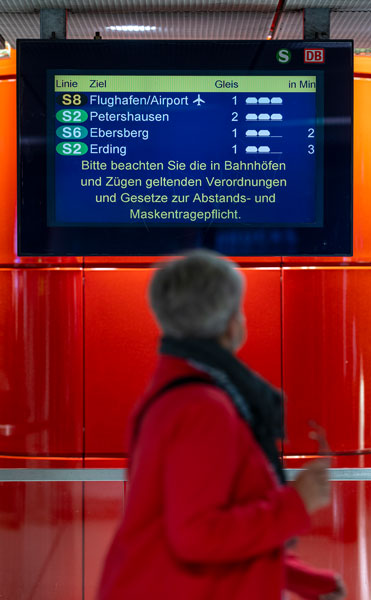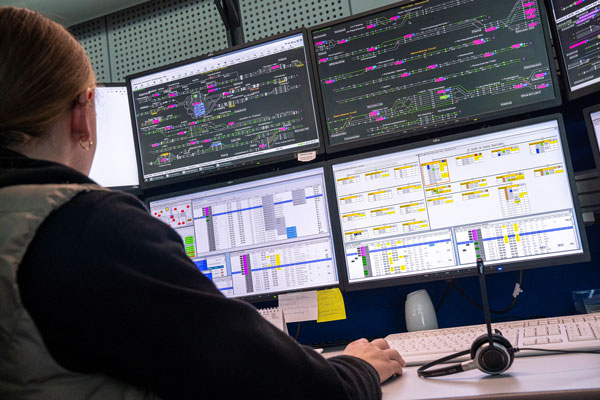Funkwerk Mobility Platform: our References
System Maris – Germany
Proven in practice: On this page you will find use cases and references relating to the use of the Funkwerk Mobilty Platform.
The redundant dual computer system MARIS was installed at 149 stations to improve passenger information in the Munich S-Bahn area. Its main function is the automatic synchronous output of passenger information on displays and loudspeakers according to the current traffic situation. MARIS is designed to meet the different requirements of S-Bahn, regional and long-distance traffic as well as external RUs at the same time. The modular software architecture connects external systems via standardised interfaces.
Receiving, distributing, evaluating – and outputting information
MARIS receives timetable changes for each train from the ISTP control system of DB Passenger Transport and the systems of the external RUs via the RIS connection service of Deutsche Bahn. From this, both dispositive deviations such as unscheduled stops, complete or partial cancellations, journeys of additional or replacement trains and forecast data, which are taken over according to their priority, are automatically calculated. The business transactions recognised by the system lead directly to the updating of passenger information on the complete route network.
MARIS receives additional forecasts and track changes in real time from the Leidis system of DB Netz AG via location messages. This means that, for example, delay, track change, entry and connection announcements are issued automatically and train cancellation is carried out.
In addition to regular operation, the system also automatically calculates passenger information in the event of minor deviations and major disruptions. This relieves the information manager and the simplified handling keeps the error rate low when modifying the passenger information.
The high degree of automation of the system reduces manual work, especially in exceptional cases. Overall, the system provides important support to the operator and at the same time a high level of information service to the passengers.

MARIS receives both the planned annual timetable and the timetable changes during the year via the standardised timetable interface of Deutsche Bahn AG. The data can be edited with the help of the integrated timetable editor and supplemented with further information relevant for passenger information.
In addition, the planned wagon stand definition and the spiral list with the corresponding train number linking information are taken over from the planning and scheduling system of the S-Bahn Munich and the timetable data are enriched accordingly. At the same time, the wagon order information for all connected RUs is transferred in real time via the DB S&S Virtual Train service. Train arrivals and departures are automatically detected via so-called object registration sensors on the station track.
Focus on the user interface
Via the user interface at the workstation, the information manager interacts with the system and receives a complete overview of the passenger information in graphical and topological form. He or she can control terminals, monitor and manually instruct the passenger information and make live announcements via VoiceIP. Additional warning announcer workstations are used to trigger passage announcements.
Predefined procedures, so-called business incident forms, are used to react conveniently in the event of an incident. A fixed procedure is stored for each situation, which automatically ensures that the corresponding timetable changes are made after the information manager has only given the train number for identification.

Central comparison of the timetables of different transport providers
The central algorithm calculates the currently valid timetable situation from the received data on the basis of preconfigured rules and generates the train-related events directly from this, such as arrival, (unscheduled) train stop, departure, delay, track change, train failure and replacement train. In doing so, it takes priority rules into account and uses configuration parameters.
Timetables of different transport providers are compared. Forecasts in the event of a delay are automatically defined for each subsequent station of the entire journey, taking into account catch-up times. In case of connection conflicts, the information manager can select alternatives. Substitute train detection is automatic for all railway undertakings integrated in MARIS. Accordingly, the general and specific information is output to the passenger via the terminals.
Display systems and acoustic passenger information
Displays run both event- and time-controlled – depending on whether the information is train-related or general. Predefined voice modules or automatically generated scrolling texts can be used for this purpose. A distinction is made between departure and arrival monitors, train indicators and special indicators (direction indicators). Depending on the requirements, different technologies are installed: LCDs and TFT displays differ in writability, colour and resolution.
With the IP public address system of the CURA product family, both live and automatic announcements can be output. In general, the volume level is configurable and different languages can be set. Texts or voice modules can be recorded in advance and repeatedly output. Train-independent announcements are usually time-controlled, while train-related announcements are usually event-controlled due to the close time reference.
Components of the
Mobility Platform
Passenger information
Passenger information systems enable the fully automatic control of all processes in the operational sequence.
Displays
Indicators, displays, columns and monitors provide passengers with visual information in real time.
Text-to-Speech
Text-to-speech is the digital generation of speech from text. Announcements can be synthesised live.
Funkwerk Mobility Platform: our references
System MARIS –
Germany
Proven in practice: On this page you will find use cases and references relating to the use of the Funkwerk Mobilty Platform.
The redundant dual computer system MARIS was installed at 149 stations to improve passenger information in the Munich S-Bahn area. Its main function is the automatic synchronous output of passenger information on displays and loudspeakers according to the current traffic situation. MARIS is designed to meet the different requirements of S-Bahn, regional and long-distance traffic as well as external RUs at the same time. The modular software architecture connects external systems via standardised interfaces.
Receiving, distributing, evaluating – and outputting information
MARIS receives timetable changes for each train from the ISTP control system of DB Passenger Transport and the systems of the external RUs via the RIS connection service of Deutsche Bahn. From this, both dispositive deviations such as unscheduled stops, complete or partial cancellations, journeys of additional or replacement trains and forecast data, which are taken over according to their priority, are automatically calculated. The business transactions recognised by the system lead directly to the updating of passenger information on the complete route network.
MARIS receives additional forecasts and track changes in real time from the Leidis system of DB Netz AG via location messages. This means that, for example, delay, track change, entry and connection announcements are issued automatically and train cancellation is carried out.
In addition to regular operation, the system also automatically calculates passenger information in the event of minor deviations and major disruptions. This relieves the information manager and the simplified handling keeps the error rate low when modifying the passenger information.
The high degree of automation of the system reduces manual work, especially in exceptional cases. Overall, the system provides important support to the operator and at the same time a high level of information service to the passengers.

MARIS receives both the planned annual timetable and the timetable changes during the year via the standardised timetable interface of Deutsche Bahn AG. The data can be edited with the help of the integrated timetable editor and supplemented with further information relevant for passenger information.
In addition, the planned wagon stand definition and the spiral list with the corresponding train number linking information are taken over from the planning and scheduling system of the S-Bahn Munich and the timetable data are enriched accordingly. At the same time, the wagon order information for all connected RUs is transferred in real time via the DB S&S Virtual Train service. Train arrivals and departures are automatically detected via so-called object registration sensors on the station track.
Focus on the user interface
Via the user interface at the workstation, the information manager interacts with the system and receives a complete overview of the passenger information in graphical and topological form. He or she can control terminals, monitor and manually instruct the passenger information and make live announcements via VoiceIP. Additional warning announcer workstations are used to trigger passage announcements.
Predefined procedures, so-called business incident forms, are used to react conveniently in the event of an incident. A fixed procedure is stored for each situation, which automatically ensures that the corresponding timetable changes are made after the information manager has only given the train number for identification.

Central comparison of the timetables of different transport providers
The central algorithm calculates the currently valid timetable situation from the received data on the basis of preconfigured rules and generates the train-related events directly from this, such as arrival, (unscheduled) train stop, departure, delay, track change, train failure and replacement train. In doing so, it takes priority rules into account and uses configuration parameters.
Timetables of different transport providers are compared. Forecasts in the event of a delay are automatically defined for each subsequent station of the entire journey, taking into account catch-up times. In case of connection conflicts, the information manager can select alternatives. Substitute train detection is automatic for all railway undertakings integrated in MARIS. Accordingly, the general and specific information is output to the passenger via the terminals.
Display systems and acoustic passenger information
Displays run both event- and time-controlled – depending on whether the information is train-related or general. Predefined voice modules or automatically generated scrolling texts can be used for this purpose. A distinction is made between departure and arrival monitors, train indicators and special indicators (direction indicators). Depending on the requirements, different technologies are installed: LCDs and TFT displays differ in writability, colour and resolution.
With the IP public address system of the CURA product family, both live and automatic announcements can be output. In general, the volume level is configurable and different languages can be set. Texts or voice modules can be recorded in advance and repeatedly output. Train-independent announcements are usually time-controlled, while train-related announcements are usually event-controlled due to the close time reference.
Components of the
Mobility Platform
Passenger information
Passenger information systems enable the fully automatic control of all processes in the operational sequence.
Displays
Indicators, displays, columns and monitors provide passengers with visual information in real time.
Text-to-Speech
Text-to-speech is the digital generation of speech from text. Announcements can be synthesised live.

References
System MARIS – Germany
The redundant dual computer system MARIS was installed at 149 stations to improve passenger information in the Munich S-Bahn area. Its main function is the automatic synchronous output of passenger information on displays and loudspeakers according to the current traffic situation. MARIS is designed to meet the different requirements of S-Bahn, regional and long-distance traffic as well as external RUs at the same time. The modular software architecture connects external systems via standardised interfaces.
Receiving, distributing, evaluating – and outputting information
MARIS receives timetable changes for each train from the ISTP control system of DB Passenger Transport and the systems of the external RUs via the RIS connection service of Deutsche Bahn. From this, both dispositive deviations such as unscheduled stops, complete or partial cancellations, journeys of additional or replacement trains and forecast data, which are taken over according to their priority, are automatically calculated. The business transactions recognised by the system lead directly to the updating of passenger information on the complete route network.
MARIS receives additional forecasts and track changes in real time from the Leidis system of DB Netz AG via location messages. This means that, for example, delay, track change, entry and connection announcements are issued automatically and train cancellation is carried out.
In addition to regular operation, the system also automatically calculates passenger information in the event of minor deviations and major disruptions. This relieves the information manager and the simplified handling keeps the error rate low when modifying the passenger information.
The high degree of automation of the system reduces manual work, especially in exceptional cases. Overall, the system provides important support to the operator and at the same time a high level of information service to the passengers.

MARIS receives both the planned annual timetable and the timetable changes during the year via the standardised timetable interface of Deutsche Bahn AG. The data can be edited with the help of the integrated timetable editor and supplemented with further information relevant for passenger information.
In addition, the planned wagon stand definition and the spiral list with the corresponding train number linking information are taken over from the planning and scheduling system of the S-Bahn Munich and the timetable data are enriched accordingly. At the same time, the wagon order information for all connected RUs is transferred in real time via the DB S&S Virtual Train service. Train arrivals and departures are automatically detected via so-called object registration sensors on the station track.
Focus on the user interface
Via the user interface at the workstation, the information manager interacts with the system and receives a complete overview of the passenger information in graphical and topological form. He or she can control terminals, monitor and manually instruct the passenger information and make live announcements via VoiceIP. Additional warning announcer workstations are used to trigger passage announcements.
Predefined procedures, so-called business incident forms, are used to react conveniently in the event of an incident. A fixed procedure is stored for each situation, which automatically ensures that the corresponding timetable changes are made after the information manager has only given the train number for identification.

Central comparison of the timetables of different transport providers
The central algorithm calculates the currently valid timetable situation from the received data on the basis of preconfigured rules and generates the train-related events directly from this, such as arrival, (unscheduled) train stop, departure, delay, track change, train failure and replacement train. In doing so, it takes priority rules into account and uses configuration parameters.
Timetables of different transport providers are compared. Forecasts in the event of a delay are automatically defined for each subsequent station of the entire journey, taking into account catch-up times. In case of connection conflicts, the information manager can select alternatives. Substitute train detection is automatic for all railway undertakings integrated in MARIS. Accordingly, the general and specific information is output to the passenger via the terminals.
Display systems and acoustic passenger information
Displays run both event- and time-controlled – depending on whether the information is train-related or general. Predefined voice modules or automatically generated scrolling texts can be used for this purpose. A distinction is made between departure and arrival monitors, train indicators and special indicators (direction indicators). Depending on the requirements, different technologies are installed: LCDs and TFT displays differ in writability, colour and resolution.
With the IP public address system of the CURA product family, both live and automatic announcements can be output. In general, the volume level is configurable and different languages can be set. Texts or voice modules can be recorded in advance and repeatedly output. Train-independent announcements are usually time-controlled, while train-related announcements are usually event-controlled due to the close time reference.
Components of the
Mobility Platform
Passenger information
Passenger information systems enable the fully automatic control of all processes in the operational sequence.
Displays
Indicators, displays, columns and monitors provide passengers with visual information in real time.
Text-to-Speech
Text-to-speech is the digital generation of speech from text. Announcements can be synthesised live.
